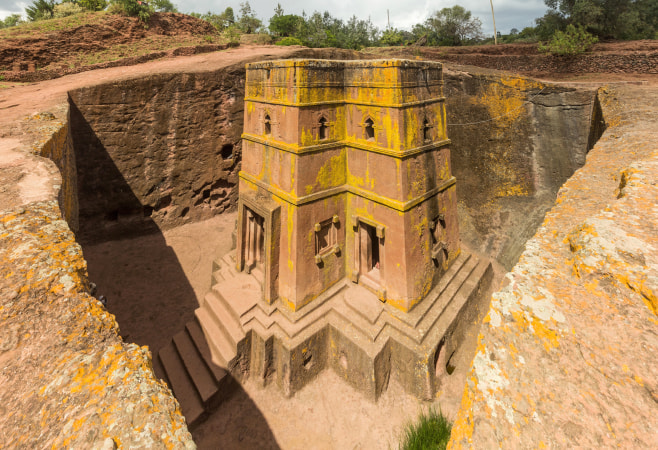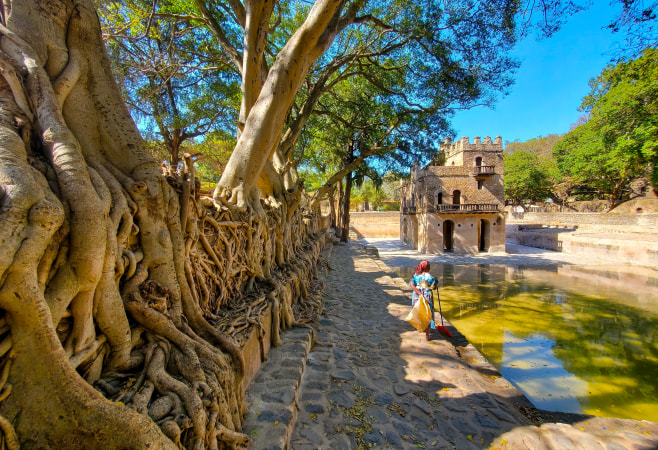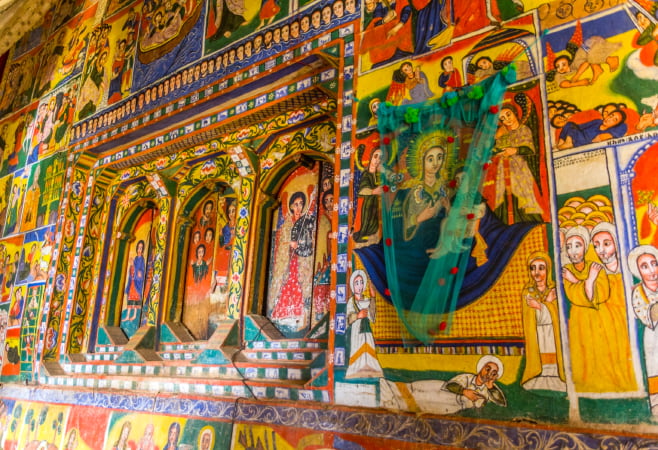Top Destinations for Historic Holidays in Northern Ethiopia
A historic Northern Ethiopia holiday is more than a vacation; it is a pilgrimage through time. This region, often called the "Cradle of Civilization," is where ancient empires rose, monolithic churches were hewn from solid rock, and medieval castles pierced the sky.
This guide is your essential companion for planning an unforgettable journey through the heart of the Ethiopian Highlands.
Why Choose Historic Northern Ethiopia Holidays?
When travelers think of Ethiopia, they often imagine coffee ceremonies, colorful markets, and highland views. But northern Ethiopia offers much more:
World Heritage Sites – Ethiopia is home to 12 UNESCO World Heritage Sites, with many of them located in the historic northern highlands.
Spiritual Journeys – From Christianity’s ancient roots in Axum to the medieval rock-hewn churches of Lalibela.
Unique Landscapes – The Simien Mountains, Lake Tana, and the Tigray highlands provide dramatic backdrops.
Cultural Immersion – Interact with local people, experience centuries-old traditions, and attend religious festivals.
Choosing historic northern Ethiopia holidays means stepping back in time while enjoying modern hospitality and warm Ethiopian hospitality.
 Northern Ethiopia is the perfect destination for history lovers
Northern Ethiopia is the perfect destination for history lovers
What Is the Northern Historic Route?
The Historic Route is Ethiopia’s most famous travel circuit, usually covered over 7–14 days. It connects the key ancient cities and religious centers, each offering a glimpse into Ethiopia’s glorious past.
1. Addis Ababa
While not part of northern Ethiopia, most tours start in Addis Ababa, Ethiopia’s capital and Africa’s diplomatic hub. Here you can:
- Visit the National Museum of Ethiopia, home of Lucy (Australopithecus afarensis).
- Explore Holy Trinity Cathedral, a landmark of modern Ethiopian Christianity.
- Experience Ethiopian cuisine, coffee ceremonies, and nightlife.
Before beginning your journey, make sure to apply for an Ethiopian e-Visa to ensure a smooth arrival at Addis Ababa Bole International Airport.
2. Bahir Dar and Lake Tana
Bahir Dar is a scenic city on the southern shores of Lake Tana, Ethiopia’s largest lake and the source of the Blue Nile.
Take a boat trip to visit island monasteries such as Ura Kidane Mihret.
See the Blue Nile Falls (Tis Issat), a spectacular natural wonder, especially during the rainy season.
Enjoy lakeside relaxation with views of papyrus boats and traditional fishing villages.
3. Gondar
Known as the Royal Enclosure, Gondar was once the capital of the Ethiopian Empire in the 17th century.
Highlights include:
- Fasil Ghebbi (Royal Castles) – A UNESCO site with castles influenced by Portuguese and Indian architecture.
- Debre Berhan Selassie Church – Famous for its angelic ceiling frescoes.
- Annual festivals like Timket (Epiphany) attract thousands of pilgrims.
 Visit Historic Northern Ethiopia is a journey across centuries of Ethiopian history
Visit Historic Northern Ethiopia is a journey across centuries of Ethiopian history
4. The Simien Mountains National Park
A natural extension of history, the Simien Mountains are often included in historic northern Ethiopia holidays.
Home to the Gelada baboon, Ethiopian wolf, and spectacular landscapes.
Trekking routes range from short hikes to multi-day adventures.
UNESCO World Heritage Site due to its biodiversity and dramatic escarpments.
5. Axum
Axum is regarded as the birthplace of Ethiopian civilization and was once the capital of the Aksumite Empire (100–940 AD).
Must-see sites include:
- Obelisks of Axum – Granite stelae dating back over 1,700 years.
- Church of St. Mary of Zion – Revered by many Ethiopians as the legendary resting place of the Ark of the Covenant, a belief deeply rooted in Ethiopia’s spiritual heritage.
- Tombs of ancient kings, archaeological museums, and relics of an empire that once rivaled Rome and Persia.
6. Lalibela
No historic northern Ethiopia holiday is complete without Lalibela, Ethiopia’s holiest city.
Rock-hewn churches – 11 medieval churches carved from solid rock in the 12th century.
Church of St. George (Bete Giyorgis) – The most iconic, shaped like a cross.
Pilgrimage center during major festivals such as Genna (Ethiopian Christmas).
Lalibela remains one of the most extraordinary human achievements, blending faith, art, and architecture.
7. Mekelle and the Tigray Rock Churches
The Tigray region is known for its dramatic cliffs and remote rock-hewn churches.
Abuna Yemata Guh – A church perched high on a cliff, accessible only by a steep climb.
Wukro Chirkos and Debre Damo Monastery are also remarkable.
Offers a blend of spirituality and adventure.
This route is ideal for a 7- to 15-day itinerary, connected by reliable domestic flights and a network of improving roads across the main tourist regions.
 Northern Ethiopia Holidays, where faith, architecture, and culture merge into an unforgettable travel experience.
Northern Ethiopia Holidays, where faith, architecture, and culture merge into an unforgettable travel experience.
Practical Advice for Your Historic Northern Ethiopia Holidays
A successful trip to northern Ethiopia requires meticulous planning to ensure a smooth and enjoyable experience. From the best time to visit to navigating the region, a little preparation goes a long way.
Best Time to Visit
The best time to embark on your historic northern Ethiopia holidays is during the dry season, which runs from October to April. The weather is consistently sunny and pleasant, with clear skies perfect for photography and sightseeing. The landscapes are lush and green after the rainy season, and the roads are more accessible.
What to Pack
It is important to pack for varying temperatures, as the highlands can be cool in the mornings and evenings. Layers are key, and comfortable, sturdy walking shoes are a must for exploring the rugged terrain and historical sites.
Navigating the Region
- Travel between the main historical sites is usually by a combination of domestic flights and private vehicles.
- Ethiopian Airlines connects major destinations such as Addis Ababa, Lalibela, Gondar, and Bahir Dar, with services to Aksum and Mekelle resuming gradually as conditions allow.
- For travel within and between cities, a private vehicle with an experienced local guide is highly recommended.
- A knowledgeable guide will not only help you navigate the roads but also provide invaluable historical context and cultural insights that you would otherwise miss.
Securing Your Visa: An Essential Step
Before you begin your journey, one of the most important steps is to secure the correct travel authorization. For most international travelers, including those from Europe, the Americas, and Asia, the Ethiopian e-visa is the most convenient option. It eliminates the need for a physical visit to an embassy and simplifies the entry process upon arrival. The application is done entirely online and is a quick, straightforward process.
 Let's book guided tours and tailor-made holidays that showcase the treasures of Northern Ethiopia
Let's book guided tours and tailor-made holidays that showcase the treasures of Northern Ethiopia
FAQs about Historic Northern Ethiopia Holidays
Is North Ethiopia safe for tourists?Many of Ethiopia’s historic sites remain welcoming to visitors and supported by solid tourism infrastructure.
Still, travelers should stay informed and check the latest government and local advisories before visiting certain northern regions, including Tigray and Afar.
What is the historical region of northern Ethiopia?
It refers to Tigray, Amhara, and Afar regions, which were home to the Aksumite Kingdom, the Zagwe dynasty, and medieval Christian empires. It is known for its ancient Christian sites, castles, and archaeological landmarks like Axum, Lalibela, and Gondar.
What is considered the historic region of northern Ethiopia?
It includes Axum, Lalibela, Gondar, Bahir Dar, and the Tigray rock churches, forming Ethiopia’s “Historic Route.”
How many days are needed for historic northern Ethiopia holidays?
At least 7–10 days are recommended, but a full two weeks allows you to explore all major sites.
Do I need a guide to visit the historic sites?
Yes, hiring local guides enriches your experience with historical insights and helps support the community.
Can I travel overland between historic northern cities?
Yes, but distances are long. Domestic flights with Ethiopian Airlines are faster and reliable for covering the Historic Route.
When is the ideal time for festivals during the historic Northern Ethiopia holidays?
January for Timkat or September for Meskel, when cultural celebrations enhance your experience.
How many days are needed for a historic northern Ethiopia vacation?
A comprehensive trip usually requires 10–14 days, but shorter itineraries of 5–7 days can focus on a few key destinations.
When is the best time to visit?
October to March is ideal, with cooler, dry weather and major festivals.
Final Thoughts
Exploring historic northern Ethiopia holidays offers a journey into some of Africa’s richest cultural and natural landscapes. Start planning your adventure today and apply for your Ethiopia e-visa to unlock the door to ancient wonders and unforgettable memories.
Related Articles
- Top Active Volcanoes in Ethiopia You Must See
- Experiencing the Ethiopian Coffee Ceremony as a Visitor
- Exploring Dorze Village: What to See and Do
- Top Travel Apps for Visiting Ethiopia
- Ethiopia Entry Requirements for African Travelers
- Bole Addis Ababa International Airport: What Travelers Need to Know
- Exploring the Gheralta Rock Churches of Ethiopia
- Ethiopian Highlands Travel Tips: Things Must See & Do
- Travel From Eritrea to Ethiopia: What Tourists Need to Know





